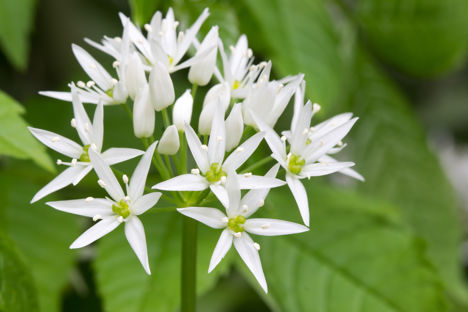
Ingredient focus: wild garlic
The star attraction in the British foraging calendar, wild garlic is appearing earlier than normal this year thanks to the mild winter. Sally Abé takes a closer look at the fragrant flower.
View more from this series:
Ingredient focusWild garlic (or ramsons) can be found growing prolifically throughout the British countryside between the months of March and June. The plant is usually found in damp areas of woodland or riverbanks, but can easily thrive in urban areas, too – you may well see some growing in your garden. You’ll be able to identify the flowers by their strong, distinctive garlicky smell.
Used in cooking for hundreds of years for its fragrant flavour and antibacterial properties (soldiers in the First World War used the plant as an antiseptic), wild garlic is the perfect representation of spring. The second warmer weather begins to make an appearance, the shoots burst through the topsoil and begin to spread like wildfire across the UK. Many gardeners consider the plant a weed; even pulling them up and throwing them onto the compost heap won’t stop them sweeping through flowerbeds the following year.
Wild garlic is part of the allium family, along with onions, leeks and (unsurprisingly) garlic. It’s a not too distant relative of the chive and can be eaten in the same way, as the stem, leaf and star-shaped white flowers are all edible. The abundance of wild garlic in the countryside is taken full advantage of by chefs, who use it to flavour all manner of dishes throughout the short season; some even preserve and ferment the leaves for use later on in the year. The makers of Cornish Yarg, a famous cheese usually covered in nettle leaves, utilise the season by creating a special wild garlic leaf-wrapped edition, which leaves the cheese with a subtle garlic flavour.
Flavour profile
Obviously, wild garlic tastes like garlic. But it differs from the more common cloves as it is more mellow and has a distinct grassy flavour. The raw leaves have a strong pungent smell, but taste delicate and sweet. Early on in the season, some leaves can be quite fiery, so make sure you sample them before adding to a recipe to avoid disasters. Use it in the same way you would normal garlic in pesto and mayonnaise.
Food matches
Wild garlic tends to pair well with ingredients that come into season at the same time. Try using it to flavour dishes containing asparagus, morel mushrooms or Jersey Royals. The leaves and flowers also work wonderfully with simple pasta dishes, risottos and salads.
For inspiration, try Pete Biggs’ quick to make and visually striking Wild garlic mayonnaise, perfect for dipping crudités into. Matthew Tomkinson takes the seasonal approach, using the leaves to flavour his dish of Wild halibut with morels and Jersey Royals, while this Wild garlic pesto means you can preserve the fresh flavour of the flowers for a little longer. Shaun Rankin’s Rump and rib of lamb with wild garlic risotto and fava beans is the perfect last spring or early summer dish and Adam Gray makes delicious little wild garlic toasts to dip into his smooth spinach soup.
Did you know?
Wild garlic plants can quickly sweep through woodland, completely covering the ground and filling the area with their unmistakable scent.
Brown bears and wild boars have developed quite the taste for wild garlic, hence the plant’s Latin name Allium Ursinum.
Wild garlic is one of the few things that are safe to forage without much knowledge – while the plants do look similar to the toxic Lily of the Valley, simply rubbing a leaf between your fingers and smelling it will tell you whether you’ve picked the correct plant or not.


